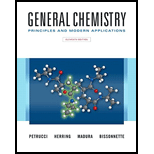
(a)
Interpretation:
To determine the term dimer.
Concept introduction:
The term dimer refers to an oligomer in which two monomer units are joined together by bonds which can either be weak or strong, intermolecular or covalent.
(b)
Interpretation:
To determine the term adduct.
Concept introduction:
The term adduct refers to the product formed as a result of direct addition of two or more molecules that are distinct and hence the result is a single reaction product which consists of all the atoms of all the components which were involved in the reaction.
(c)
Interpretation:
To determine the term calcination.
(d)
Interpretation:
To determine the term amphoteric oxide.
Concept introduction:
An amphoteric compound refers to an ion or a molecule that has the ability to react with both an acid and a base. There are many metals which form amphoteric oxides and hydroxides.
(e)
Interpretation:
To define the term three -center two -electron bond.
Concept introduction:
The term bond refers to the force of attraction which exists between two atoms or molecules. The term electron refers to the negatively charged particles which are found in the atom.
Want to see the full answer?
Check out a sample textbook solution
Chapter 21 Solutions
General Chemistry: Principles and Modern Applications, Loose Leaf Version (11th Edition)
- What causes linkage isomerisation?arrow_forwardYou want to separate Cd2* and Fe2+ (initial concentration 103 mol/L) by means ofprecipitation of the corresponding sulphides. Is therea pH range in which one of the two metals is precipitated quantitatively(concentration in the solution less than or equal to 10" mol/L) is precipitatedwhile the other is still completely_in solution?Calculate and name this pH range where pH values below 0are set equal to O. Illustrate the situation graphically by drawingarrow_forwardIs bis(oxalato)platinate(II) a diamagnetic square planar complex? Yes or no? How about at the start of an electrochemical reaction, is the cell potential (Ecell) of a concentration cell always zero? Yes or no?arrow_forward
- What volume of 0.200 M NaOH is necessary to neutralize the solution produced by dissolving 2.00 g of PCl3 is an excess of water? Note that when H3PO3 is titrated under these conditions, only one proton of the acid molecule reacts.arrow_forward(a) What are the different oxidation states exhibited by the lanthanoids? (b) Write two characteristics of the transition elements. (c) Which of the 3d-block elements may not be regarded as the transition elements and why?arrow_forwardThe standard reduction potential for the reaction [Co( H 2 O)6]3+(aq)+e[CO( H 2 O)6]2+(aq) is about 1.8 V. The reduction potential for the reaction [Co( NH 3 )6]3+(aq)+e[Co( NH 3 )6]2+(aq) is +0.1 V. Calculate the cell potentials to show whether the complex ions,. [Co( H 2 O)6]2+ and or [Co( NH 3 )6]2+, can be oxidized to the corresponding Cobalt (III) complex by oxygen.arrow_forward
- Sodium hypochlorite is produced by the electrolysis of cold sodium chloride solution. How long must a cell operate to produce 1.500103 L of 5.00% NaClO by mass if the cell current is 2.00103 A? Assume that the density of the solution is 1.00 g/cm3.arrow_forwardThe following reactions all occur in a blast furnace. Which of these are redox reactions? (a) 3Fe2O3(s)+CO(g)2Fe3O4(s)+CO2(g) (b) Fe3O4(s)+CO(g)3FeO(s)+CO2(g) (c) FeO(s)+CO(g)Fe(l)+CO2(g) (d) C(s)+O2(g)CO2(g) (e) C(s)+CO2(g)2CO(g) (f) CaCO3(s)CaO(s)+CO2(g) (g) CaO(s)+SiO2(s)CaSiO3(l)arrow_forwardThe equilibrium constant for the reaction 2CrO42(aq)+2H+(aq)Cr2O72(aq)+H2O is 31014 . What must the pH be so that the concentrations of chromate and dichromate ion are both 0.10 M?arrow_forward
 Chemistry by OpenStax (2015-05-04)ChemistryISBN:9781938168390Author:Klaus Theopold, Richard H Langley, Paul Flowers, William R. Robinson, Mark BlaserPublisher:OpenStax
Chemistry by OpenStax (2015-05-04)ChemistryISBN:9781938168390Author:Klaus Theopold, Richard H Langley, Paul Flowers, William R. Robinson, Mark BlaserPublisher:OpenStax Chemistry: Principles and ReactionsChemistryISBN:9781305079373Author:William L. Masterton, Cecile N. HurleyPublisher:Cengage Learning
Chemistry: Principles and ReactionsChemistryISBN:9781305079373Author:William L. Masterton, Cecile N. HurleyPublisher:Cengage Learning General Chemistry - Standalone book (MindTap Cour...ChemistryISBN:9781305580343Author:Steven D. Gammon, Ebbing, Darrell Ebbing, Steven D., Darrell; Gammon, Darrell Ebbing; Steven D. Gammon, Darrell D.; Gammon, Ebbing; Steven D. Gammon; DarrellPublisher:Cengage Learning
General Chemistry - Standalone book (MindTap Cour...ChemistryISBN:9781305580343Author:Steven D. Gammon, Ebbing, Darrell Ebbing, Steven D., Darrell; Gammon, Darrell Ebbing; Steven D. Gammon, Darrell D.; Gammon, Ebbing; Steven D. Gammon; DarrellPublisher:Cengage Learning Principles of Modern ChemistryChemistryISBN:9781305079113Author:David W. Oxtoby, H. Pat Gillis, Laurie J. ButlerPublisher:Cengage Learning
Principles of Modern ChemistryChemistryISBN:9781305079113Author:David W. Oxtoby, H. Pat Gillis, Laurie J. ButlerPublisher:Cengage Learning Chemistry & Chemical ReactivityChemistryISBN:9781337399074Author:John C. Kotz, Paul M. Treichel, John Townsend, David TreichelPublisher:Cengage Learning
Chemistry & Chemical ReactivityChemistryISBN:9781337399074Author:John C. Kotz, Paul M. Treichel, John Townsend, David TreichelPublisher:Cengage Learning Chemistry: The Molecular ScienceChemistryISBN:9781285199047Author:John W. Moore, Conrad L. StanitskiPublisher:Cengage Learning
Chemistry: The Molecular ScienceChemistryISBN:9781285199047Author:John W. Moore, Conrad L. StanitskiPublisher:Cengage Learning





